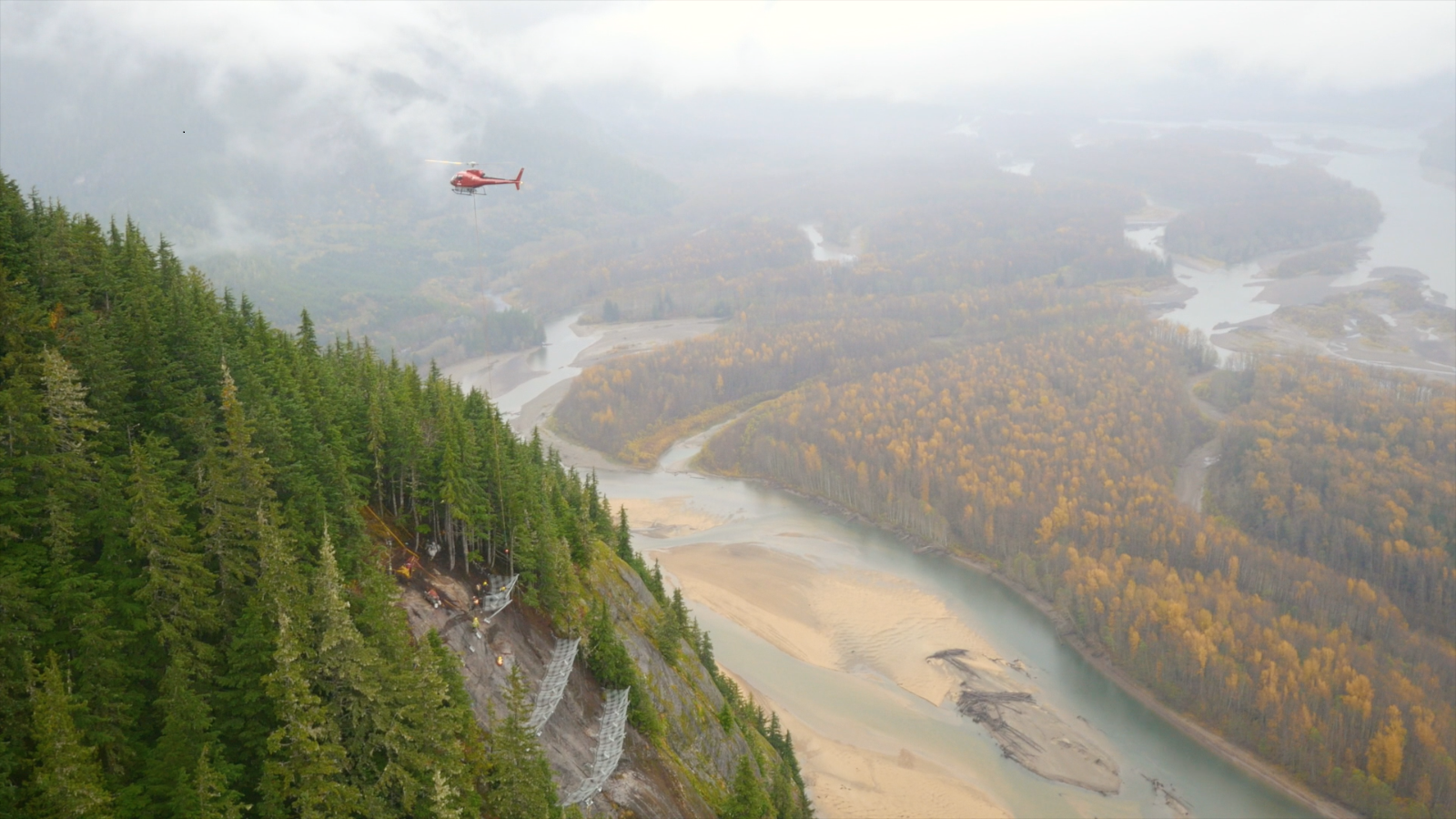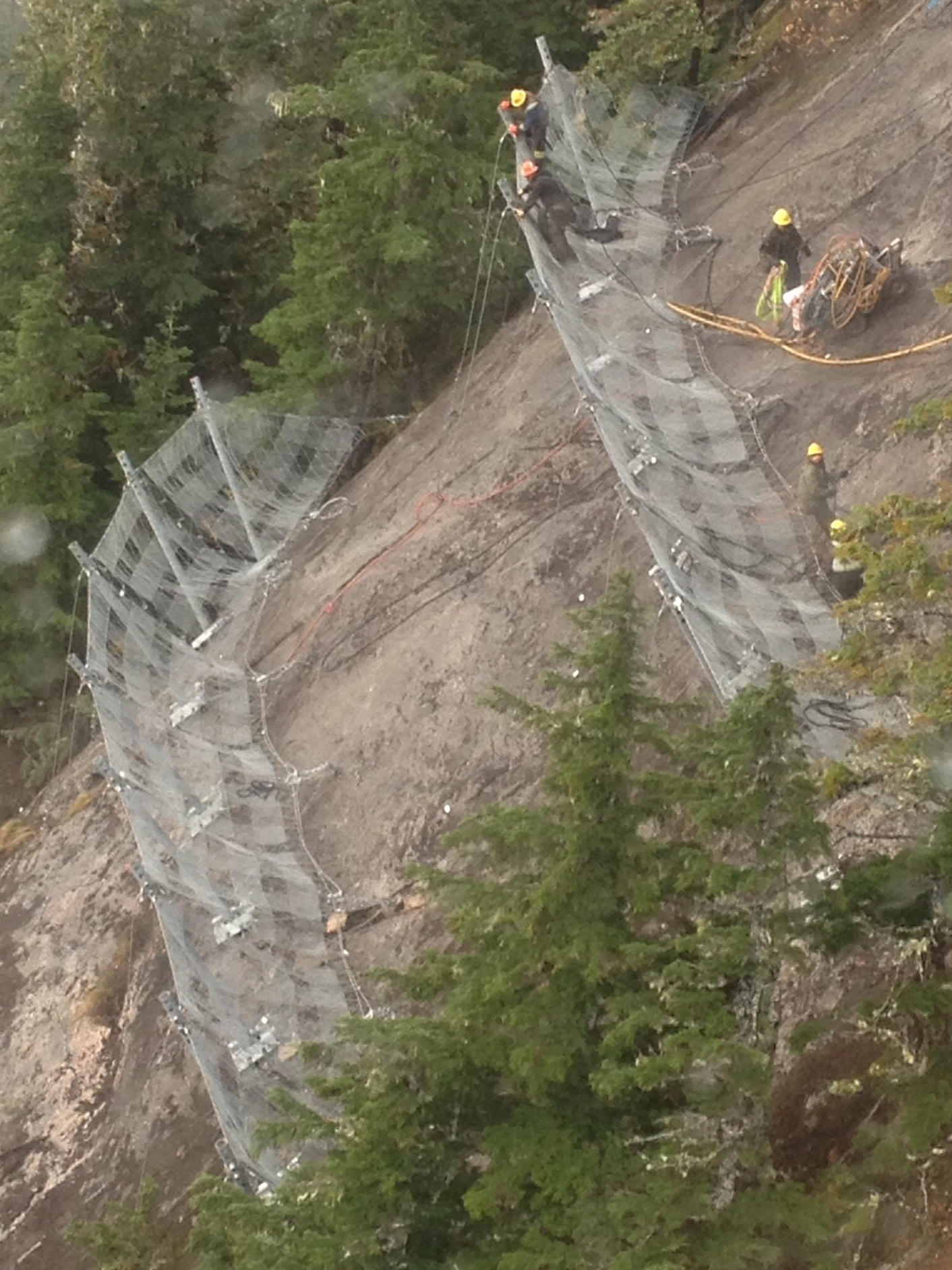From volume 108, winter 2014-15
By Steve Brushey

Photo: Because the site was only accessible by helicopter, Quantum Helicopters in Terrace was contracted, providing daily access to the site and slinging of all materials, requiring a total of 75 hours of flying. By Steve Brushey.
APPROXIMATELY 80% OF HIGHWAY avalanche road closures along Highway 16W occur in the 35 Mile avalanche area, located 56.4km west of Terrace. Compounding the problem is restrictive narrow lane width, due to a CN rail track on the south side of the highway and the 35 Mile rock bluff on the north side. Poor sight lines, and lack of a ditch and snow storage add to the 35 Mile problem. This area is also prone to ice fall, resulting in motor vehicle accidents and numerous near misses. Currently the avalanche hazard at 35 Mile is managed through preventative closures and avalanche control, which fall under the Ministry of Transportation and Infrastructure Avalanche Safety Plan. The ice fall hazard remains the responsibility of the maintenance contractor and is mitigated using a high powered rifle with limited success.
During the winter of 2012-13, an increase in ice fall garnered the attention of Ministry representatives. A consultant was hired to find a solution to both the ice fall and avalanche hazard. Thurber Engineering and Dynamic Avalanche Consulting were retained to provide ice fall solutions, rock structure mapping and avalanche fencing design.
The Thurber/Dynamic report’s scope only considered avalanche fencing structures. The study did not include avalanche control products, as the Ministry of Transportation Avalanche and Weather Program preferred a longer term, more permanent solution that would eliminate the need to do control work at the East Bluffs, significantly reduce or eliminate avalanche hazard forecasting, and provide a cost effective solution. Of interest, McElhanney Engineering was retained by a regional project management team, which looked at several high level solutions which included rock cuts, tunnel, causeway and snow shed options. Costs ranged from $37 million to $140 million. Other than the snow shed option, avalanche snow fencing would be required for all of the other options. Avalanche snow fencing made the most sense economically in both the short and long term, given the scope of the initial project.
The MoT Northwest Avalanche Program was concerned about the potential for the snow fences to increase the amount of melt water through melt-freeze cycles, leading to a possible increase in ice fall. In order to further study the potential problem, the Mid-Chutes section of 35 Mile was selected for a trial fencing project. If meltwater or ice fall increased, the likelihood of falling ice impacting the highway would be negligible due to terrain configuration at the Mid-Chutes. In addition, the avalanche hazard at the Mid-Chutes would be mitigated.
During the early spring of 2013, the Northwest Avalanche Program gathered the necessary permits required to proceed with the project. These included archeological and environmental assessments, and a permit to construct a helicopter pad in advance of any required work. During this time, Thurber/Dynamic made site visits to the area to gather information and data required to complete their initial report. This report was finalized in August 2013.
Due to various delays, in the fall of 2013 the project was postponed until 2014. In December 2013, 81.7m of 3.0Dk GeoBrugg Spider Avalanche Fencing arrived in Terrace and was stored for the winter.
In the spring of 2014, the Northwest Avalanche Program began administrating a contract for the installation of the fencing at the Mid-Chutes. Retaining an Engineer of Record for the project did prove to be a challenge, however once finalized, the planning and design of the installation began. This took longer than anticipated. Due to the overall cost estimate, the project now qualified as a Major Works Project and was advertised on BC Bid for qualified installers. The contract closed in early September and the contract was awarded to Pacific Blasting and Demolition of Burnaby, BC. Installation began on September 26 and was completed November 4, 2014.
The installation consisted of several phases involving site preparation and danger tree removal, fence and anchor layout, anchor drilling and grouting, anchor testing, and fence installation. During this time, technical support was provided by Geobrugg, Dynamic Avalanche Consulting and Thurber Engineering. Because the site was only accessible by helicopter, Quantum Helicopters in Terrace was contracted, providing daily access to the site and slinging of all materials, requiring a total of 75 hours of flying. A gravel pit close to the work site was used for the daily mobilization of crew and materials.
Traffic control was required throughout the duration of the project, requiring delays of up to 20 minutes to ensure public safety while Pacific Blasting and Demolition crews performed their work 350m above the highway. During the initial phase of danger tree removal, several track occupancy permits were required from CN Rail in order to safeguard the rail right of way.
Despite a very wet fall, the project was delayed for only three days when crews could not work. This proved testament to the hardy nature of the installation crew and the expert flying of Quantum Helicopter pilots.

Photo: Pacific blasting and demolition crews perform their work
350 metres above the highway. By Steve Brushey.
With the trial phase fencing installation now complete, the fencing will be monitored throughout the winter of 2014-15 to determine the feasibility of the next phase of avalanche fencing for the East Bluff area. The East Bluff phase requires approximately 400m of fencing to complete the main avalanche area. Once complete, the final phase of ice fall hazard mitigation will follow, requiring an ice retaining structure and drape nets. A short, low elevation rock cut is also a possibility.
Moving ahead, the East Bluff start zones of 35 Mile avalanche area face environmental challenges which include nesting birds, bats and goat kidding areas. In addition, archaeological points of interest need to be preserved. The size of the area will also require the construction of another helicopter pad and many more track occupancy permits from CN Rail. An early analysis suggests the work can be completed over two months which if undertaken during the summer months with longer days and technically better weather, should promote efficiencies and cost savings.





